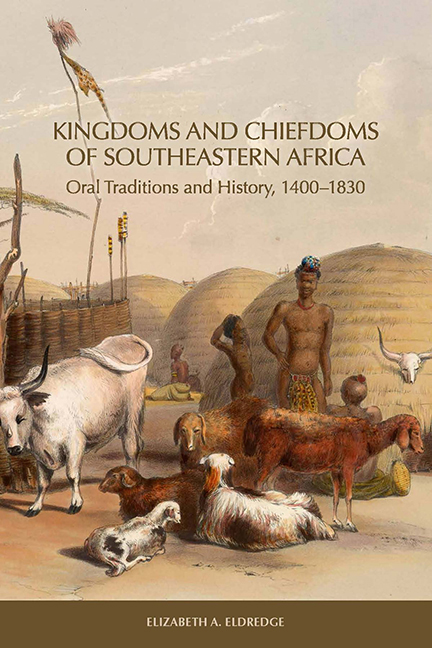Book contents
- Frontmatter
- Contents
- List of Illustrations
- Preface
- 1 History and Oral Traditions in Southeastern Africa
- 2 Oral Traditions in the Reconstruction of Southern African History
- 3 Shipwreck Survivor Accounts from the Sixteenth and Seventeenth Centuries
- 4 Founding Families and Chiefdoms East of the Drakensberg
- 5 Maputo Bay Peoples and Chiefdoms before 1740
- 6 Maputo Bay, 1740–1820
- 7 Eastern Chiefdoms of Southern Africa, 1740–1815
- 8 Zulu Conquests and the Consolidation of Power, 1815–21
- 9 Military Campaigns, Migrations, and Political Reconfiguration
- 10 Ancestors, Descent Lines, and Chiefdoms West of the Drakensberg before 1820
- 11 The Caledon River Valley and the BaSotho of Moshoeshoe, 1821–33
- 12 The Expansion of the European Presence at Maputo Bay, 1821–33
- 13 Southern African Kingdoms on the Eve of Colonization
- Appendix A Ama Swazi King Lists
- Appendix B Chronology of Conflicts, Migrations, and Political Reconfiguration East of the Drakensberg in the Era of Shaka
- Appendix C Interviewees from the James Stuart Collection of Oral Traditions
- Notes
- Bibliography
- Index
10 - Ancestors, Descent Lines, and Chiefdoms West of the Drakensberg before 1820
Published online by Cambridge University Press: 14 March 2018
- Frontmatter
- Contents
- List of Illustrations
- Preface
- 1 History and Oral Traditions in Southeastern Africa
- 2 Oral Traditions in the Reconstruction of Southern African History
- 3 Shipwreck Survivor Accounts from the Sixteenth and Seventeenth Centuries
- 4 Founding Families and Chiefdoms East of the Drakensberg
- 5 Maputo Bay Peoples and Chiefdoms before 1740
- 6 Maputo Bay, 1740–1820
- 7 Eastern Chiefdoms of Southern Africa, 1740–1815
- 8 Zulu Conquests and the Consolidation of Power, 1815–21
- 9 Military Campaigns, Migrations, and Political Reconfiguration
- 10 Ancestors, Descent Lines, and Chiefdoms West of the Drakensberg before 1820
- 11 The Caledon River Valley and the BaSotho of Moshoeshoe, 1821–33
- 12 The Expansion of the European Presence at Maputo Bay, 1821–33
- 13 Southern African Kingdoms on the Eve of Colonization
- Appendix A Ama Swazi King Lists
- Appendix B Chronology of Conflicts, Migrations, and Political Reconfiguration East of the Drakensberg in the Era of Shaka
- Appendix C Interviewees from the James Stuart Collection of Oral Traditions
- Notes
- Bibliography
- Index
Summary
Oral traditions identify the chiefs and chiefdoms that migrated over centuries from the west and north as well as from east across the Drakensberg into the Caledon River region, which became the heart of the BaSotho kingdom in the nineteenth century. The oral traditions remembered by their descendants in Lesotho in the nineteenth century narrate stories of inheritance confLicts over succession to chieftaincies, raids, wars, migration, and resettlement and attach these events to ancestors named in their genealogies who were individually and specifically associated with these momentous events in their history. The people who came to identify themselves as the BaSotho belonged to the kingdom of Lesotho, which was unified under the leadership of the Moreno e Moholo, Paramount Chief Moshoeshoe, beginning in the 1820s. By the time of the emergence of Moshoeshoe's nascent kingdom from a small chiefdom in the early 1820s, the people under his rule included descendants of San hunter-gatherers who had lived in the region for tens of thousands of years and immigrant mixed farmers who cultivated grains and herded stock. The farmers were made up of Nguni-speaking peoples who had migrated as chiefdoms from east of the Drakensberg Mountains and Sotho-Tswana speaking chiefdoms that had immigrated from the north and west.
Residual Stone Age communities, known in modern times as Baroa, Basarwa, Bushmen, or San and associated with the KwaZulu-Natal region and areas of the Cape Colony districts and modern Namibia and Botswana, had been concentrated in the high mountain areas and adjacent regions of modern Lesotho for at least twenty thousand years and survived to trade and sometimes intermix socially over centuries with Iron Age farming communities. As D. F. Ellenberger observed, their historical presence in the Lesotho-Orange Free State area has always been marked by the names of rivers and locations carrying their language and names. By the nineteenth century,
the Bushmen were divided into clans, with their headquarters in caves in which they painted pictures of the animal which gave its name to the clan. For instance, all the Bushmen of Herschel Quthing and Barkley East had their headquarters at the cave of the Eland near Dordrecht.
- Type
- Chapter
- Information
- Kingdoms and Chiefdoms of Southeastern AfricaOral Traditions and History, 1400–1830, pp. 237 - 266Publisher: Boydell & BrewerPrint publication year: 2015



